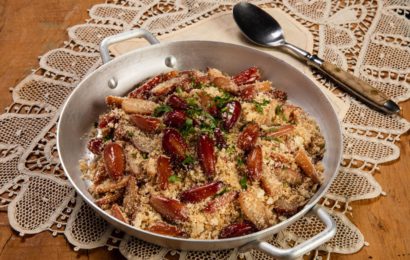
Makes: Serves 2

Preparation Time: 2 hours, plus the time to marinate

Level: Medium/ Difficult
INGREDIENTS
- 2 LARGE PORK CHOPS, WITH ABOUT 1½ FINGER IN HEIGHT
- ¼ ONION
- 2 GARLIC CLOVES, MINCED
- ¼ DEDO-DE-MOÇA PEPPER, DESEEDED
- ½ TEACUP OF WHITE WINE
- 200 G OF PORK BELLY
- 2 FRESH ITALIAN SAUSAGES
- 2 TEACUPS OF BAKED BEANS
- 2 TABLESPOONS OF FINE MANIOC FLOUR
- 1 BANANA
- 2 TABLESPOONS OF ALL-PURPOSE FLOUR
- 1 EGG, BEATEN
- 3 TABLESPOONS OF CORNMEAL
- 1 BUNCH OF COLLARD GREENS, CUT INTO STRIPS
- 2 EGGS
- 1 TABLESPOON OF BUTTER
- CORN OIL, FOR FRYING
- SALT AND BLACK PEPPER TO TASTE
PREPARATION
Season the pork chops with salt and black pepper. In a blender or food processor, blend the onions, garlic dedo-de-moça pepper, and wine; spread the marinade over the meat and set it aside for 1 hour. Season the pork belly with salt and black pepper, rubbing thoroughly; bake in an over at 180°C for 40 minutes, or until golden; set aside. In a heated pot, sear the pork chops (set the marinade aside) and the sausage. Transfer to a baking dish and set aside. In the same pot, braise the marinade, turn down the heat and add the beans. Adjust the seasoning and add the manioc flour, stirring constantly as to not form lumps; cook for a bit and set aside. Cut the bananas in half and coat them with all-purpose flour, beaten egg, and cornmeal; deep fry in hot oil and set aside. Cut the roasted pig belly into cubes and deep fry it; remove it and drain it when the pieces are golden brown. Put the baking dish with the meats in an oven at 200°C for 10 minutes. Braise the remaining garlic with a dash of corn oil and add the collard greens; wait until they wither a bit, season with salt and set aside. Fry the eggs with butter. Serve the pork chops and sausage with the virado (beans), pig belly, the fried banana, collard greens, fried egg, and white rice.
IN DETAIL: There is a lot of controversy about who created the virado à paulista, despite the dish’s name (“paulista” means “from São Paulo”). It’s part of the Minas Gerais culinary tradition, but it’s origins are found in São Paulo, where it has its very own day for showing up on the fixed menu lunches: Mondays.



